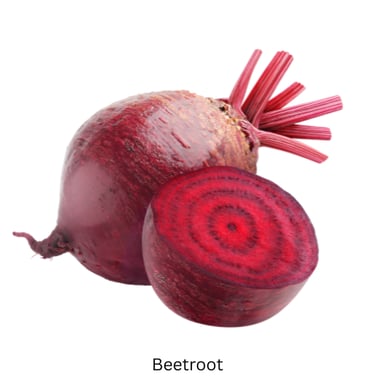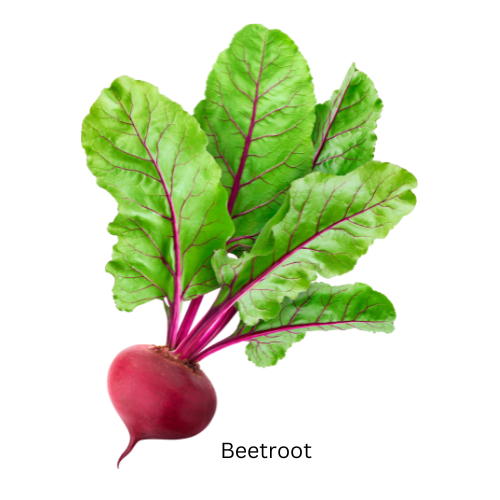

Beetroot
Beetroot, or beets in North America, is a root vegetable scientifically known as Beta vulgaris. It's known for its deep red or purple colour and is used in various culinary and health-related applications. Here's a comprehensive look at Beetroot:
Nutritional Profile
Rich in Nutrients: Beets are low in calories and a great source of vitamins and minerals, including folate (vitamin B9), manganese, potassium, iron, and vitamin C.
Dietary Fiber: They contain moderate fibre, which is beneficial for digestive health.
Health Benefits
Heart Health: Beetroots are high in nitrates, which the body converts into nitric oxide. Nitric oxide aids in the relaxation and expansion of blood vessels, enhancing blood.
Circulation and helping lower blood pressure.
Exercise Performance: Dietary nitrates are believed to boost athletic performance, increasing the efficiency of mitochondria, which are responsible for—energy production in cells.
Anti-Inflammatory Properties: Beets contain pigments called betalains, which may possess several anti-inflammatory properties.
Cancer Prevention: Some studies suggest that the beets' phytochemicals can help fight cancer, although more research is needed.
Culinary Uses
Salads and Side Dishes: Often used in salads, either cooked, pickled, or raw. They can also be roasted, boiled, or steamed.
Beet Juice: Popular for its health benefits, beet juice is a common way to consume beets in a more concentrated form.
Soups: Beets are the main ingredient in borscht, a traditional Eastern European soup.
Desserts: These can be used in baking, adding moisture and natural sweetness to cakes and pastries.
Varieties
Red Beets: The most common variety, known for their vibrant colour.
Golden Beets: Milder in flavour and don't stain as much as red beets.
Chioggia Beets: Also known as candy cane striped beets, they have red and white concentric circles.
Storage and Preparation
Storage: in the refrigerator for several weeks. It's best to store the leaves and roots separately.
Preparation: They can be eaten raw, juiced, roasted, boiled, or steamed. The skin is typically peeled before eating.
Other Uses
Natural Dyes: The vibrant colour of beets can be used as a food colouring and fabric dye.
Sugar Production: Sugar beets, a different variety of Beta vulgaris, are commercially grown for sugar production.
Potential Downsides
Oxalates: Beets contain oxalates, which can contribute to kidney stone formation in susceptible individuals.
Beeturia: Consuming beets can cause some people's urine or stools to turn pink or red, which is harmless but can be alarming.
In conclusion, Beetroot is a versatile vegetable with numerous health benefits, culinary uses, and interesting varieties.
Its valuable nutritional content makes it an excellent addition.
A balanced diet.
Nutritional benefits
Beetroot offers many nutritional benefits, making it a significant component of a nutritious diet. Here are some of the vital dietary advantages of consuming beetroots:
1. Rich in Essential Nutrients
Low in Calories: Beets have a low-calorie count, making them a weight-friendly food choice.
Fibre: They provide a rich source of dietary fibre, advantageous for maintaining digestive health.
Vitamins and Minerals: Beets are particularly rich in folate (vitamin B9), crucial for DNA synthesis and repair. They also provide significant amounts of manganese, essential for bone health and metabolic processes, and potassium, necessary for blood pressure regulation.
2. Heart Health
Nitrates: Beetroots are rich in nitrates that the body converts into nitric oxide. This conversion is beneficial for reducing blood pressure by widening blood vessels, enhancing blood flow, and consequently reducing the risk of heart diseases. Additionally, beetroots contain Betaine, which may support heart health by decreasing homocysteine levels. High levels of homocysteine are associated with a higher risk of heart disease.
3. Athletic Performance
Improved Oxygen Use: The nitrates in beets can increase athletic performance by improving the efficiency of mitochondria, which produce energy in cells. This may improve muscle oxygenation during exercise, enhancing stamina and performance.
Endurance Boost: Studies have shown that beetroot juice can increase physical endurance and stamina, making it popular among athletes.
4. Anti-Inflammatory Properties
Betalains: These pigments give beets their distinctive colour and possess anti-inflammatory properties. They may help in reducing inflammation in conditions like arthritis.
5. Antioxidant Benefits
Free Radical Scavenging: Beets contain various antioxidants, which protect cells from free radicals, potentially reducing the risk of chronic diseases.
6. Cancer-Fighting Properties
Phytochemicals: Certain compounds in beets have been researched for their ability to restrict the growth of cancer cells. However, more research is needed in this area.
7. Liver Health
Detoxification Support: Beets contain compounds that may support the body's natural detoxification processes, potentially promoting liver health.
8. Blood Sugar Control
Low Glycemic Load: Despite their sweetness, beets have a low glycemic load, meaning they are suitable for people with diabetes.
9. Cognitive Health
Increased Blood Flow to the Brain: The nitrates in beets may help increase blood flow to the brain, potentially aiding in cognitive functioning and possibly reducing the risk of dementia.
10. Digestive Health
Fibre Content: The fibre in beets can aid in regular bowel movements and contribute to a healthy gut.
In summary, the diverse nutritional profile of beetroots can contribute significantly to overall health, offering benefits for the heart, muscles, brain, and digestive system, along with potential anti-inflammatory and anti-cancer properties. As with any food, they should be consumed as a balanced diet.
In Ayurveda
In Ayurveda, Beetroot is valuable due to its numerous health benefits and balancing properties. Ayurveda focuses on balancing the three doshas (vital energies) — Vata, Pitta, and Kapha — to maintain health, and Beetroot is thought to have qualities that can influence these energies. Here's how Beetroot is viewed and used in Ayurvedic practice:
Ayurvedic Perspective on Beetroot
Dosha Impact: Beetroot is primarily considered to balance Vata and Kapha doshas due to its grounding and nourishing properties. However, because of its natural sweetness and slight heating quality, it should be used moderately by those with high Pitta dosha.
Rasa (Taste): In Ayurveda, Beetroot is categorized under sweet (Madhura) and astringent (Kashaya) tastes. The sweet taste is believed to be nourishing and building, while the astringent taste helps in blood purification and controlling excessive Pitta.
Virya (Potency): Beetroots have a slightly warming effect (Ushna Virya), which can be beneficial in balancing Vata and Kapha doshas, which are cold and dry or heavy and slow in nature, respectively.
Vipaka (Post-Digestive Effect): Beetroot's post-digestive effect is sweet (Madhura Vipaka) and considered nourishing for the body tissues.
Health Benefits in Ayurveda
Digestive Health: Beetroots are used to improve digestion and stimulate metabolism. They are believed to aid in the proper assimilation of food.
Blood Purifier: Due to its astringent properties, Beetroot is often used as a blood purifier in Ayurveda. It's thought to help detoxify the blood and liver.
Heart Health: Ayurveda recognizes the benefits of Beetroot in supporting heart health, partly due to its ability to improve blood circulation and reduce blood pressure.
Energizing Properties: Beets are considered a Sattvic food in Ayurveda, meaning they promote clarity, balance, and harmony. They are often recommended for their energizing effect on the mind and body.
Skin Health: Due to its purifying properties, Beetroot is also used in Ayurvedic practices to improve skin health and complexion.
Ayurvedic Preparations and Usage
Raw or Cooked: Beetroots can be consumed raw and cooked, although Ayurveda generally recommends cooked vegetables for better digestion.
Juices and Smoothies: Beetroot juice is a popular Ayurvedic preparation, often mixed with herbs and spices to balance its cooling effects.
Spices for Balance: When preparing beetroot dishes, Ayurvedic cooking often includes cumin, ginger, or black pepper to balance its sweet taste and aid digestion.
Precautions
In Ayurveda, dietary recommendations are highly individualized based on one's constitution (Prakriti) and the current state of doshas (Vikriti). People with high Pitta or those experiencing Pitta-related imbalances should be cautious with beetroot consumption due to its slightly heating nature.
In summary, in Ayurveda, Beetroot is valued for its nutritional properties, ability to balance specific doshas, and role in promoting overall health. Its use is often tailored to individual needs, combined with specific herbs and spices to enhance its benefits and counterbalance any potential adverse effects.
In Traditional Chinese Medicine (TCM),
In Traditional Chinese Medicine (TCM), a comprehensive health system rooted in ancient Chinese philosophy, foods and herbs is strategically used to balance the body's Qi (essential energy) and the dynamics pertaining to the five elements, which are (water, wood, fire, earth, metal.)
Beetroot's unique attributes and therapeutic benefits in TCM are defined by its individual nature and influence on the body's organs and energy systems.
TCM Perspective on Beetroot
Nature and Flavor: Beetroot is considered to have a sweet flavour and a neutral thermal character. In TCM, foods with a sweet taste are generally believed to nourish the body and strengthen the organs.
Organ Affinity: Beetroot is thought to have an affinity for the spleen and stomach, organs responsible for digestion and assimilation of nutrients in TCM. It's believed to aid in nourishing the blood and supporting digestive health.
Blood Tonic: One of the primary uses of Beetroot in TCM is as a blood tonic. According to TCM principles, it's thought to nourish and purify the blood, which is crucial for preserving health and vitality.
Qi Energy: Beetroot is also considered to help regulate Qi, particularly in aiding the movement and function of the spleen and stomach Qi.
Health Benefits in TCM
Digestive Health: By supporting the spleen and stomach, Beetroot is used to improve digestion, alleviate constipation, and promote regular bowel movements.
Nourishing Blood: Beetroot is often recommended for conditions related to blood deficiency in TCM, such as anaemia, dizziness, or pale complexion. Its ability to nourish and build blood makes it a valuable dietary addition.
Liver Health: While not its primary focus in TCM, Beetroot is sometimes used to support liver health, given its role in blood purification and nourishment.
Menstrual Health: Due to its blood-nourishing properties, Beetroot can benefit women with menstrual irregularities or discomforts associated with blood deficiency.
Preparation and Consumption
Cooking Methods: In TCM, cooking methods are essential. Beetroots are usually eaten cooked rather than raw to aid digestion and absorption, as raw foods are believed to be more taxing on the digestive system.
Combining with Other Foods: To enhance its effects, Beetroot might be combined with other blood-nourishing foods and herbs in TCM dietary therapy.
Precautions
Individualized Approach: Similar to Ayurveda, TCM emphasizes a personalized approach to diet and health based on an individual's specific imbalances and constitution.
Moderation: While beneficial, Beetroot should be consumed in moderation, especially by individuals with digestive issues or excessive dampness in the body, as per TCM theory.
In summary, in Traditional Chinese Medicine, Beetroot is valued for its nourishing properties, particularly for the blood and the digestive system. Its neutral and sweet nature makes it a versatile food for balancing Qi and improving overall health. As with all TCM dietary recommendations, its use should be tailored to the individual's needs and conditions.
Preparation
1.1 Preparing Beetroot can be a delightful culinary experience due to its versatility and the rich, earthy flavours it offers. Here are some common and effective ways to prepare beetroots:
Basic Preparation
Washing: Rinse beetroots under cold water, scrubbing the skin to remove dirt.
Peeling: You can peel beetroots before or after cooking. The skin comes off more quickly after they are cooked and cooled.
Trimming: Cut off the beetroot tops and the root end. The greens can be saved and cooked separately as they are also nutritious.
Cooking Methods
Boiling:
Place the whole or sliced beetroots into a pot and fill it with water until they are covered.
Add a small amount of salt, and then bring the water to a boil temperature.
Then lower the heat and let it simmer. Cook the beetroots until soft, which typically takes 30 to 60 minutes, varying in size.
After tender, drain the water and allow the beetroots to cool down before peeling.
Roasting:
o roast beetroots in the oven:
Preheat oven to approximately 400°F (200°C).
Cut the beetroots into halves or quarters and mix them with olive oil, a bit of salt, and any other seasonings you prefer.
Arrange them on a baking .
Roast in an oven until tender, usually 30-40 minutes.
Steaming:
Cut beetroots into smaller pieces.
Please place them in a steaming basket over boiling water.
Cover and steam until they are tender, which can take 15-30 minutes.
Microwaving:
Place peeled and sliced beetroots in a microwave-safe dish.
Add water, cover the dish, and microwave on high until tender (about 10 minutes).
Raw Preparations
Salads:
Grate raw beetroots and add them to salads.
Mix them with arugula, goat cheese, nuts, and a vinaigrette.
Juicing:
Combine raw Beetroot with fruits and vegetables like apples, carrots, and ginger for a nutritious juice.
Smoothies:
Add chopped Beetroot to your smoothies for added nutrients and colour.
Pickling
Thinly slice or dice beetroots.
Boil a mixture of vinegar, water, sugar, and pickling spices.
Pour this hot mixture over the beetroots and let them marinate.
Serving Suggestions
Garnishes: Garnish dishes with herbs like parsley or dill to complement the earthy flavour of beets.
Dressings: A squeeze of lemon or a dash of vinegar can enhance the flavour.
Pairing: Beetroots pair well with creamy ingredients like goat cheese or yoghurt.
Storage
Cooked beetroots can be stored in the refrigerator for up to a week.
If you have boiled beetroots with their skin on, you can easily peel them by rubbing the skin off under cold water.
Tips
Beets can stain your hands and cutting boards. Wearing gloves and using a non-porous cutting board can help.
The cooking will be different depending on the size and age of the beetroots. Young, small beetroots will cook more quickly.
Add Beetroot into your diet can be both healthy and delicious. Beetroots add vibrant colour, flavour, and nutrients to any meal, whether roasted, boiled, steamed, or consumed raw.
Top of Form
Recipes
1. Classic Roasted Beetroot
Ingredients:
4-6 medium beetroots, cleaned and peeled
Two tablespoons of olive oil
Salt and pepper, to taste
Optional: herbs like thyme or rosemary
Instructions:
Add oven to around 400°F (200 °C).
Cut the beetroots into quarters or halves, depending on their size.
Add them in olive oil, salt, pepper, and optional herbs.
Place on baking paper or sheets and roast them in the oven for 30-40 minutes or until tender and slightly caramelized.
Put them on another plate or add to salads.
2. Beetroot and Goat Cheese Salad
Ingredients:
Mixed salad greens
2-3 roasted beetroots, sliced
Goat cheese, crumbled
Walnuts, toasted
For the dressing: olive oil, balsamic vinegar, honey, salt, and pepper
Instructions:
Arrange the salad greens on a plate.
Top with sliced roasted beetroots, crumbled goat cheese, and toasted walnuts.
Whisk together olive oil, balsamic vinegar, honey, salt, and pepper to make the dressing.
Put the sauce over the salad and serve.
3. Beetroot Soup (Borscht)
Ingredients:
4-5 medium beetroots, peeled and grated
One onion, chopped
Two carrots, chopped
One potato, chopped
Vegetable or chicken broth
One tablespoon vinegar
Salt and pepper, to taste
Sour cream for serving
Fresh dill for garnish
Instructions:
In a large pot, sauté the onion, carrots, and potato until soft.
Add the grated beetroots and enough broth to cover the vegetables.
Boil the reduced heat and simmer until all vegetables are tender.
Add vinegar, salt, and pepper.
Serve hot with two tablespoons of sour cream and a sprinkle of fresh dill.
4. Beetroot Hummus
Ingredients:
One can of chickpeas, drained and rinsed
One medium roasted Beetroot peeled
Two tablespoons tahini
Two cloves garlic
Juice of 1 lemon
Salt, to taste
Olive oil
Instructions:
Blend the roasted Beetroot, chickpeas, tahini, garlic, and lemon juice until smooth.
During blending, slowly add olive oil until you reach your desired consistency.
Season with salt to taste.
Serve with vegetable sticks or pita bread.
5. Chocolate Beetroot Cake
Ingredients:
Two medium beetroots pureed
1 1/2 cups flour
1/4 cup unsweetened cocoa powder
One teaspoon of baking soda
Pinch of salt
1 cup sugar
1/2 cup vegetable oil
Two eggs
One teaspoon of vanilla extract
Instructions:
Preheat oven to 350°F (175°C). Grease and flour a cake pan.
Put flour, cocoa powder, baking soda, and salt in a bowl and mix them.
Whisk together the sugar, oil, eggs, and vanilla extract in another bowl.
Mixt both dry ingredients with the wet ingredients and mix until just combined.
Fold in the pureed beetroots, put them into a buttered pancake and bake for 25-30 minutes.
Let the cake cool before serving.
These recipes showcase how Beetroot can be cooked in various dishes, from salads and soups to dips and even desserts. Enjoy experimenting with these recipes and discovering the unique flavour that Beetroot adds to each word!


